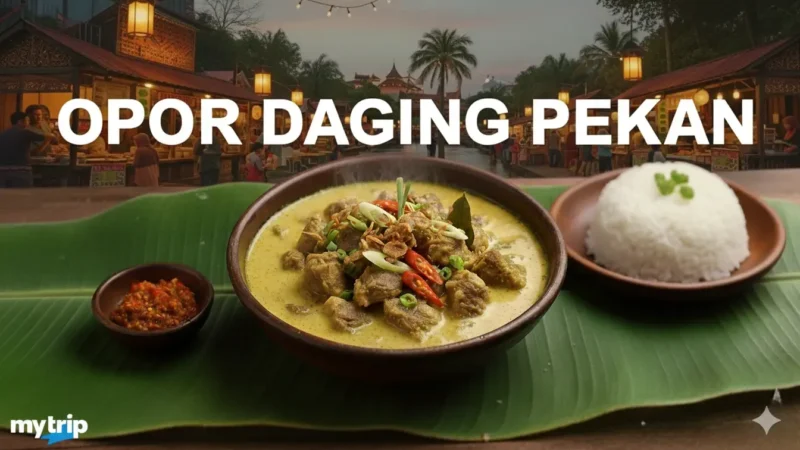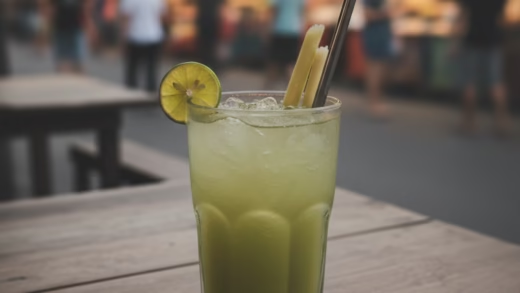Opor Daging Pekan

Synopsis
Opor Daging Pekan is a traditional Malay dish originating from Pekan, Pahang, Malaysia. It’s a rich, creamy beef stew cooked in coconut milk with aromatic spices and kerisik (toasted coconut paste). Known for its deep flavor and festive appeal, this dish is a culinary gem in Pahang’s royal town heritage.
Malaysian Food
In Malaysia’s diverse cuisine, Opor Daging Pekan represents the Malay traditional festive dishes, often served during Hari Raya, weddings, and royal banquets. It stands alongside rendang and gulai as a hallmark of Malay culinary artistry.
Origin
The dish originates from Pekan, Pahang, a royal town known for its authentic heritage recipes. Influenced by royal kitchen traditions, Opor Daging Pekan was once a delicacy prepared for palace ceremonies and community feasts.
Category
- Type: Traditional Main Course
- Cuisine: Malay / Pahang Regional Cuisine
- Dish Type: Beef Stew with Coconut Milk
Appearance
Opor Daging Pekan has a thick, golden-brown gravy with a glossy texture. The beef pieces are tender and coated in rich, spiced coconut sauce, often garnished with fried shallots.
Ingredients
- 500g beef, cut into cubes
- 1 cup thick coconut milk (santan pekat)
- 1 cup thin coconut milk (santan cair)
- 3 tbsp kerisik (toasted coconut paste)
- 3 stalks lemongrass (bruised)
- 2 kaffir lime leaves
- Salt, sugar, and seasoning to taste
Ground spices:
- 5 shallots
- 3 garlic cloves
- 1-inch ginger
- 1-inch galangal
- 1-inch fresh turmeric
- 2 tbsp opor spice mix (or kurma powder)
Preparation
- Heat oil and sauté the blended spices until fragrant and oily.
- Add lemongrass and opor spice, stir well.
- Add beef pieces and mix until coated.
- Pour in thin coconut milk, simmer until beef is tender.
- Add thick coconut milk, kerisik, lime leaves, salt, and sugar.
- Cook slowly until the gravy thickens and oil separates.
Equipment
- Blender or mortar and pestle
- Cooking pot or wok
- Wooden spatula
- Measuring cups and spoons
Variations
- Opor Ayam Pekan – uses chicken instead of beef
- Spicy Opor Daging – adds chili paste for extra heat
- Royal Opor – includes extra herbs like pandan leaves for aroma
Taste
Rich, creamy, slightly sweet, and mildly spiced — with the deep umami of slow-cooked beef.
Texture
Smooth, thick coconut gravy with tender, melt-in-the-mouth beef chunks.
Aroma
A fragrant blend of lemongrass, toasted coconut, and spices that fills the kitchen with a warm, festive scent.
Sound
The soft simmering sound of coconut milk bubbling as it thickens — a sign that the dish is nearing perfection.
Cultural Significance
Opor Daging Pekan is often associated with royal feasts, Eid celebrations, and communal gatherings. It signifies generosity, unity, and the warmth of Malay hospitality.
Symbolism
The richness of the coconut milk symbolizes prosperity and abundance, while the slow-cooked nature of the dish represents patience and care in tradition.
Regional Cuisine
It is a key part of Pahang’s regional cuisine, highlighting the state’s preference for mild, coconut-based dishes and traditional spice blends.
Social Context
Usually prepared for special occasions, family gatherings, and festive events, the dish serves as a unifying meal that brings families and communities together.
Nutritional Information (per serving, approx.)
- Calories: ~450 kcal
- Protein: 25g
- Fat: 35g
- Carbohydrates: 10g
- Fiber: 2g
Health Benefits
- Rich in protein from beef
- Contains lauric acid from coconut milk, which supports immunity
- Provides essential minerals like iron and magnesium
Dietary Restrictions
- Not suitable for vegetarians or vegans
- Can be adapted with tofu or tempeh for plant-based versions
Allergens
- Coconut (for those allergic to tree nuts or coconut)
- Possible traces of gluten depending on spice mix used
Cost
Approximate cost: RM 25 – RM 40 per serving (depending on beef quality and ingredient source).
Production
Traditionally homemade, though some Malaysian restaurants and caterers now prepare and sell Opor Daging Pekan for festive seasons.
Sustainability
Using locally sourced beef and coconut supports local farmers and reduces carbon footprint. Traditional cooking also promotes slow food culture and preservation of culinary heritage.
Availability
Commonly available in Pahang food festivals, Malay restaurants, and Hari Raya food bazaars across Malaysia.
History
Historically, Opor Daging was served in royal kitchens of Pahang. Over time, it spread to local households, maintaining its status as a prestigious and symbolic dish of celebration.
Anecdotes
Elders in Pekan often say that “Opor without kerisik is like a king without a crown,” emphasizing the importance of roasted coconut paste in achieving the dish’s authentic taste.
How to Prepare
Follow these simple steps:
- Blend the spices.
- Sauté until fragrant.
- Add beef and stir well.
- Pour in coconut milk and simmer slowly.
- Add kerisik and seasoning.
- Cook until thick and flavorful.
FAQ
Q1: Can I use chicken instead of beef?
Yes, you can make Opor Ayam Pekan, a lighter but equally tasty version.
Q2: How long does it take to cook?
About 1.5 to 2 hours for the beef to become tender.
Q3: How to store leftovers?
Keep refrigerated for up to 3 days, or freeze for up to 2 weeks.
Q4: Can it be made without coconut milk?
Coconut milk is essential for the authentic flavor, but you may substitute with cashew cream or evaporated milk for a lighter version.
Conclusion
Opor Daging Pekan is not just food—it’s a reflection of heritage, patience, and community spirit. With its creamy texture, bold aroma, and royal history, this traditional Pahang specialty remains one of Malaysia’s most beloved festive dishes.














Comments are closed.